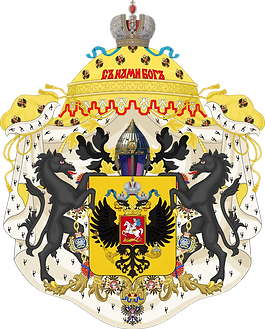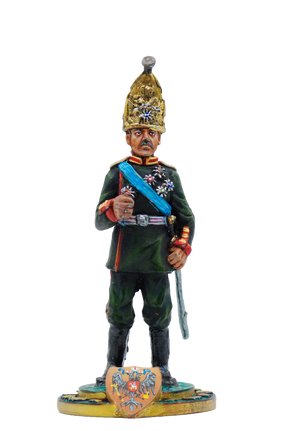
Michael Alexandrovich
Grand Duke of Russia
Grand Duke Michael Alexandrovich of Russia (4 December [O.S. 22 November] 1878 – 13 June 1918) was the youngest son and fifth child of Emperor Alexander III of Russia and youngest brother of Nicholas II. He was de jure Emperor of Russia after his brother Nicholas II abdicated in 1917 and proclaimed his brother "Emperor Michael II", but Michael declined to take power a day later. Michael was born during the reign of his paternal grandfather, Alexander II. He was then fourth in line to the throne after his father and elder brothers Nicholas and George. After the assassination of his grandfather in 1881, he became third in line and, in 1894, after the death of his father, second in line. George died in 1899, leaving Michael as heir presumptive to Nicholas II. The birth of Nicholas's son Alexei in 1904 moved Michael back to second in line, but Alexei was gravely ill with hemophilia and Michael suspected the boy would die, leaving him as heir. Michael caused a commotion at the imperial court when he took Natalia Sergeyevna Wulfert, a married woman, as a lover. Nicholas sent Michael to Orel to avoid scandal but this did not deter Michael, who travelled frequently to see his mistress. After the couple's only child, George, was born in 1910, Michael brought Natalia to St. Petersburg, where she was shunned by society. In 1912, Michael shocked Nicholas by marrying Natalia in the hope that he would be removed from the line of succession. Michael and

Natalia left Russia to live in exile abroad in France, Switzerland and England. After the outbreak of World War I, Michael returned to Russia, assuming command of a cavalry division. When Nicholas abdicated on 15 March [O.S. 2 March] 1917, Michael was named as his successor instead of Alexei. Michael, however, deferred acceptance of the throne until ratification by an elected assembly. He was never confirmed as emperor and, following the Russian Revolution of 1917, he was imprisoned and murdered.

Pavlovsky Guard Regiment was a Russian Imperial Guard infantry regiment. It was formed out of 2 battalions of the Moscow Grenadiers in November 19, 1796. They were given the title of Pavlovsky Life-Guard on April 13, 1813 for their deeds during the 1812 Patriotic war. The Pavlovsky Grenadiers were formed from 2 detached battalions of the Moscow Grenadiers in November 19, 1796. The basis of their formation was the 77th Tengisky infantry regiment who possessed a similar uniform. They were sent as part of the expedition to Holland in 1799. They were sent to Hanover as part of the Hanover Expedition in 1805 and participated in the War of the Fourth Coalition as well. They're noted to have taken part in battles such as Battle of Czarnowo, where they repulsed the 2nd French attack and under the command of Major Palibin and Lieutenant Colonel Lokhov recaptured a height on the Russian left, dislodging the French in hand-to-hand fighting and recapturing a light battery. The battle of Czarnowo is also where the regiment is known to have distinguished themselves in the fighting. Their participation in the Battle of Eylau included flanking the French under Major Makhov and Captain Panov, utilising a battalion and 2 companies respectively. They turned back a cavalry charge from Murat's horsemen and captured multiple prisoners, and went on to repulse attacks from Moran,
Saint-Illaire and Gudin's divisions. With the regiment's battalions effectively dispersed across the 3rd Infantry corps under Tuchkov's 1st Western Army and the 32nd infantry division, they fought in numerous battles. The Battle of Klyastitsy is among their distinguishing moments. Under Captain Kyrlov, the 2nd battalion pursued the dislodged French, who had set fire to the only bridge across the Nischu river. They stormed the bridge regardless and continued a pursuit of the French infantry, routing them off the field at bayonet point. Their contributions to the Battle of Borodino were made in the fight against V Corps (Grande Armée), initially repulsing them from the Utitska village and heavily damaging a French column in the fighting. On the day of April 13, 1813, they were given the title of Pavlovsky Life-Guard for the courage rendered in the Patriotic war.

The House of Romanov was the reigning imperial house of Russia from 1613 to 1917. They achieved prominence after Anastasia Romanovna married Ivan the Terrible, the first crowned tsar of all Russia. Nicholas II, the last Emperor of Russia, and his immediate family were executed in 1918, but there are still living descendants of other members of the imperial house. The house consisted of boyars in Russia (the highest rank in the Russian nobility at the time) under the reigning Rurik dynasty, which became extinct upon the death of Feodor I in 1598. The Time of Troubles, caused by the resulting succession crisis, saw several pretenders and imposters lay claim to the Russian throne during the Polish occupation. On 21 February 1613, the Zemsky Sobor elected Michael Romanov as tsar, establishing the Romanovs as Russia's second reigning dynasty. Michael's grandson, Peter I, who took the title of emperor and proclaimed the Russian Empire in 1721, transformed the country into a great power through a series of wars and reforms. The direct male line of the Romanovs ended when Elizabeth died childless in 1762. As a result,
her nephew Peter III, an agnatic member of the House of Holstein-Gottorp (a cadet branch of the German House of Oldenburg that reigned in Denmark), ascended to the throne and adopted his Romanov mother’s house name. Officially known as members of the House of Romanov, descendants after Elizabeth are sometimes referred to as Holstein-Gottorp-Romanov.

Standard of the Emperor of Russia on land, adopted in 1858. There is a widespread version that for the first time the tsar's standard with an eagle holding four sea maps in its beaks and paws was hoisted already on 8 (19) September 1703 on a new frigate named "Standart". However, this fact is not confirmed by the sources - the full list of flags with which the "Standart" set sail is preserved: "white, blue and two red flags, all with crosses in their beaks", as well as signal flags: white, blue, red, striped. Later, the four cards in the beaks and paws of the double-headed eagle on the imperial ship standard were more concretised - images of the Baltic, White, Caspian and Black Seas were placed on them. The ship's standard was hoisted on the mainmast of a ship or on the bow flagpole of a boat. Under Emperor Paul I, a palace standard also appeared, which was hoisted above the palace of the sovereign's stay and work. In the centre of the cloth of this flag, which for some time was white, and later yellow (gold), was placed the image of the Russian national emblem - a black double-headed eagle with a sceptre and orb.
Awards: Sash and star of the Order of St. Andrew the Apostle the First-Called, Stars of the Imperial Order of Saint Alexander Nevsky, the Imperial Order of the White Eagle, the Imperial Order of Saint Stanislaus and the Imperial Order of Saint Anna.










